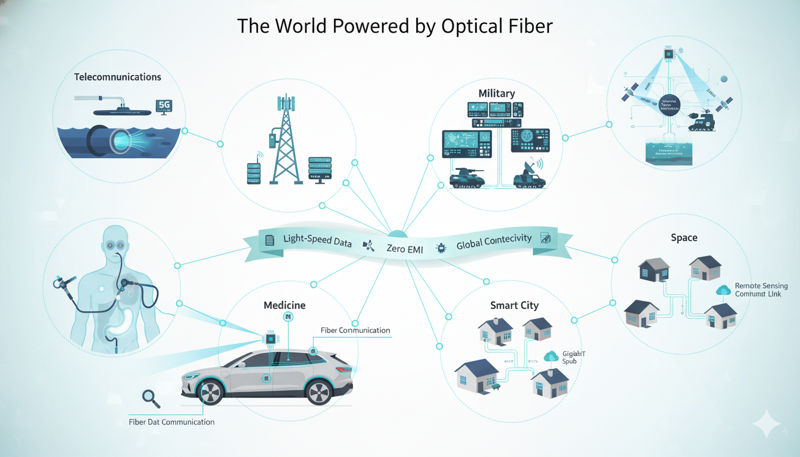Cable & Wire | High quality and excellent service at reasonable prices.
info@zion-communication.com
Author: James Publish Time: 17-11-2025 Origin: Site
Optical Fiber is a revolutionary technology enabling the world to be connected.
It is a flexible and transparent medium made from silica, glass, or plastic. Optical Fiber carries information in the form of light by reflection through the principle of total internal reflection.
Compared to copper:
Higher bandwidth
Longer distances
No electromagnetic interference (EMI)
More secure
Lightweight
Optical fiber is used today in almost every industry, including telecommunications, medicine, aerospace, and automotive.
Lightweight & thin (smaller than a hair)
High bandwidth
Unaffected by electromagnetic interference
Encrypted data transfer
Long-distance communication
Low attenuation & low latency
Non-combustible
Requires trained installation personnel
Difficult and tricky to join or splice
Costs more when installing
Unlike metal wires, they become brittle
Requires costlier equipment for testing

Application Area | Typical Use Case | Key Benefits |
Communication Systems | Long-distance data, voice & video | High bandwidth, low loss, EMI-free |
Medical Equipment | Endoscopes, diagnostic tools | Flexible, safe, minimally invasive |
Internet | Fiber broadband & FTTx | Fast speed, large data capacity |
Automotive | Lighting, sensors, in-car networking | Lightweight, fast response |
Military | Mission systems, secure communication | High security, EMI immunity |
Space Applications | Satellites, laser systems | Lightweight, high reliability |
Cable Television | HD broadcast distribution | Wide coverage, low cost |
CCTV & Security | High-bandwidth video backhaul | Long distance, reliability |
Inspection Devices | Hard-to-reach areas | Flexibility, clarity |
Telephone Networks | Long international trunk lines | Stable, low interference |
■ Communication Systems
Optical Fiber Communication permeates the globe.
It carries voice, video data, and binary (digital) signals using infrared light.
Benefits:
Very high-speed bandwidth
Near-zero signal loss
No electromagnetic interference
Secure transmission
Stable high-quality signal
Applications:
Submarine fiber optic cables
5G/4G cellular backhaul networks
Enterprise-level fiber optic networks
Data Centers & Cloud Computing centers
Optical fiber is used widely in medicine as it is non-toxic, flexible, and thin.
Applications:
Endoscopy
Otoscopy & Ophthalmic devices
Surgical lighting
Laser surgery systems
Biomedical equipment
Benefits of fiber:
Non-toxic, non-radioactive, and safe
Flexibility to reach many cavities
Supports minimally invasive surgery
Modern internet runs on fiber optic broadband (FTTH/LTE/FTTx).
Benefits of Optical Fiber for internet:
Gigabit speed
Low latency for gaming/cloud services
Very long-distance without any repeaters
High bandwidth capacity
Optical Fiber replaces copper in:
Home user broadband
Data centers
ISP backbone infrastructure
Cloud computing services
Modern vehicles use Optical Fiber for vehicle illumination as well as data communication.
Applications:
Car interior & exterior lighting (LED & Optical Fiber cables)
Intra-vehicle communication (upgraded oil)
Collision detection
Airbag triggering devices
Autonomous driving sensors
Benefits:
Very lightweight
High speed, faster than electrical signals
No EMI interference
Robust, durable, energy-saving
Telephone communication is done through Optical Fiber, local and international.
Applications:
Local landline systems
Submarine Communications
5G small cell fronthaul
Intercontinental telephone communication network
Benefits:
Very short transmission time
Stable signal transmission
Robust, non-interfered
Fast communication
Modern-day CCTVs require high-speed bandwidth for long-distance signal transmission.
Typical applications of Optical Fiber:
IP CCTV Security systems
Enterprise CCTV networks
Campus security systems
Industrial video security systems
An application to reach inaccessible areas.
Typical optical Fiber Inspection applications:
Borescope instruments
Maintenance inspection equipment
Pipeline and turbine inspections
Aircraft Engine System Inspection
Benefits:
Flexible, thin fiber diameter
Imaging capabilities
Safe illumination
Military applications require high-speed bandwidth, reliable, interference-free communication.
Typical Optical Fiber applications ARE:
Avionics
Mission control systems
Undersea communications
Radar System Link data interconnections
Sensor fusion & Weapon guidance
Secure battlefield communications
Benefits:
No jamming/EMI
Very lightweight for aircraft and missile payloads
Data encryption capabilities
Space communications are based on Optical Fiber with minimal weight value, and other superior characteristics.
Application:
Satellite communications
LIDAR
Remote sensing
High power laser communications
Space Probes Data network systems
Hyperspectral imaging
Benefits:
Minimal power loss
Very high bandwidth
Long-lasting protection against space radiation for copper wiring
Optical Fiber is widely used for signal communications for TV channels.
Benefits of Optical Fiber for TV signals:
Very high bandwidth (HD/4K/8K)
Long-distance systems are cheaper than copper cable
Many subscribers are supported on a single cable
Less signal loss than copper
That is why modern-day CATV networks are based on fiber ↓ HFC
What are the most common applications of Optical Fiber?
Telecom, internet, automobiles, medicine, military, cameras, space applications, CATV
Why is Optical Fiber better than Copper?
Higher bandwidth, higher speed, longer distances, EMI free, and secure
How is Optical Fiber used in Medicine?
Fiber optic endoscopy, surgery lighting, biomed applications, diagnostic imaging, ophthalmic devices
What role does Optical Fiber play in Automobile systems?
Interior/exterior lighting, infotainment, defense collision detection, autonomous driving
Why is Optical Fiber critical for modern Internet?
Provides gigabit speed and low latency, which copper cannot
Is Optical Fiber cost-effective?
Optical Fiber installs at a premium cost, requires no maintenance and becomes cheaper in the long run
Optical Fiber is critical in today’s digital age.
It secures high bandwidth, long-distance, and loss-free transmission for telecommunication, medicine, automotive, space, military and everyday applications.
Optical Fiber will continue to find applications due to the ever-increasing bandwidth, secure transmissions, and reliability in more fields than today, smart cities, autonomous driving, and deep space communications.
Contact us for more information

James is a technical manager and associate at Zion Communication.
Specializes in Optical Fiber communications, FTTH Solutions,
Fiber optic cables, ADSS cable, and ODN networks.
james@zion-communication.com
+86 13777460328
